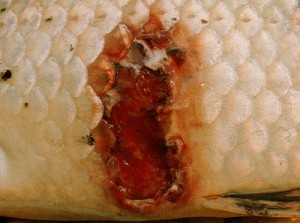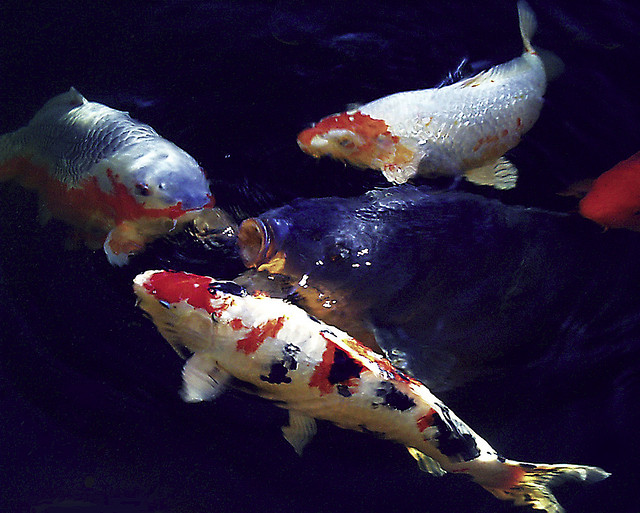Aeromonas, or Aeromonas hydrophila if you want to get scientific, is a pond bacteria. Aeromonas is one of the most common bacteria to cause infections in koi fish, manifesting itself as open wounds on the surface of the koi. That infection goes by the name of Ulcer Disease and Hole In the Side disease. This bacteria is also responsible for fin and mouth rot as well as dropsy (or pine cone disease) if left untreated.
It is important to note that it is one of the most common infections, because Aeromonas is ALWAYS present in your pond. If you have a koi pond you have the Aeromonas bacteria. As destructive as it can be, however, this bacteria does have a positive side. It feasts primarily on fish feces. But given the chance it will do the same on your koi.
Aeromonas is an opportunistic pathogen. Under normal circumstances, when a fish’s immune system is operating at 100%, the fish has no problem fighting off the bacteria and preventing it from causing problems. However, if a fish’s immune system is weakened or compromised, aeromonas will strike. It finds its way into a host (in this case your fish) through any opening in your koi’s naturally defensive slime coat. So any nick, scratch or parasite bite is a potential entryway for the Aeromonas bacteria. It is why it is important that you attempt to minimize the number of stressors and parasites in your pond.
Although the ulcers can show up anytime during the year, they are more likely to manifest in the Spring once the water temperatures start to rise and your koi’s immune system hasn’t quite got the kick start it needs to fight off this bacteria.
NOTE: Aeromonas is always in the water. One fish with an ulcer doesn’t mean that all fish are “diseased” or “infected”
Aeromonas is active in the temperatures between approximately 55ºF and 78ºF (dubbed “Aeromonas Alley) while your koi’s immune system isn’t at optimal levels. (This article by Luther C. Chien discusses the relationship between water temperature and the rise of bacterial Aeromonas infections.)
Left untreated, the small red or white pimple will become a small lesion on the skin that will continue to grow bigger, eventually exposing the muscle tissues under the skin, and so allow other forms of infection to get a foothold.
How Can I Help to Prevent Infections?
Although you can’t get rid of Aeromonas, there are ways to lessen the chance of it causing an infection. As we said earlier, keeping all those environmental factors that can stress your koi to a minimum is critical. A weakened or depressed immune system makes it easier for the bacteria to get in. Here are some simple steps you can take to lessen the chance of infections
- Clean, clean and clean again—make sure all filters are clean and that you keep organic waste as low as possible
- Frequent water changes—this is a good practice in general, but keeping the water fresh (and dechlorinated of course) can keep the bacteria in low concentrations
- Proper oxygen levels—keep an eye on the level of dissolved O2 in your water. Below 6ppm and you are looking at oxygen deprivation which is a precursor to disease. it also allows bacteria to flourish.
- Consistent pH levels—wide fluctuations in pH balance can spell disaster for your koi’s immune system. Do your best to keep your pH consistently above 7.5
- Use a probiotic food – Blue Ridge Koi’s Probiotic Plus contains three ingredients scientifically proven to boost immune system function and prevent infection
- Don’t overfeed—use temperature-appropriate quantities for Spring feedings as less food at lower temperatures means less waste for the Aeromonas to feed on.
- Don’t overstock your pond—overcrowding affects the pond’s ecosystem with more waste and less O2 as well as a high likelihood of disease transmission.
- Handle With Care—if you have to transport your koi, do so gently as to minimize the likelihood of damage
How Do I Address an Infection?
First the koi will need to be quarantined in a tank with higher water temperatures to boost the immune system. In our experience, depending on how severe the ulceration has become, raising the temperature of the water (within optimal parameters) to 80-82ºF and feeding medicated food has proven successful in the treatment of Aeromonas.
Salt can help with the loss of electrolytes and fluids from the wound as well as killing off most parasites (should there be any). Three pounds of salt per 100 gallons of water will achieve the desired salinity.
Cleaning the ulcer is the next step. Hydrogen peroxide on the wound will clean it out. Putting a topical antibacterial ointment on the fish or bathing it in tricide-neo can help to combat and stop other forms of infection entering the koi, it but it won’t cure it.
For high value koi, further steps can be taken. The preferred method to stop an infection once it has ulcerated is an injectable antibiotic (like Baytril). Unfortunately, the newer strains of Aeromonas are becoming more resistant to antibacterial treatments as a result of overuse of antibiotics.
The range of products advertised and methods used by enthusiasts (and offered on forums) is a broad one, so consulting a vet for a professional opinion is probably your best defense from further damage.
How Do I Know that the Koi is Healing?
Using the method we outlined above, we had success with the ulcer beginning to heal in as little as 2-3 days.
It begins as a whitish covering over the open ulcer, and (depending on the severity of the ulcer in the first place) will eventually heal completely in 1-3 weeks—provided proper care is given. Depending on how long the ulcer was allowed to progress before healing began, it is possible that the scales will eventually grow over that spot again.
Whenever possible, keep the koi in treatment until completely healed. The new tissue on a healing ulcer is tender and any scrape or bump on the affected area could start the process all over again.
If the infection has progressed to the point where you can see internal organs through the ulcer then it may be too far gone for your koi to heal.
Next Day Koi appreciates the time, effort and emotional investment that combating infection involves. It is why all of our koi fish for sale undergo a 14-day quarantine period in separate holding facilities during which time they are closely monitored for any signs of infection or health issues.
To find out how we can get your Living Jewel to you at some of the most competitive shipping costs available, contact one of our representatives.


“For high value koi, further steps can be taken”
I have “worthless” koi that are invaluable to me. How can I find an aquatic veterinarian? I’ve called every vet nearby and they all kinda laughed that I wanted to treat my fish. I don’t mind giving injections but I’d need a pro to show me how.
Here is a list of fish veterinarians – https://www.fishvets.org/tools/locator/locator.asp?id=30
All you would need is one to write the prescription for antibiotics. You can then order the antibiotics online, and there are tutorial and videos available on line that can help guide you through the injection process.